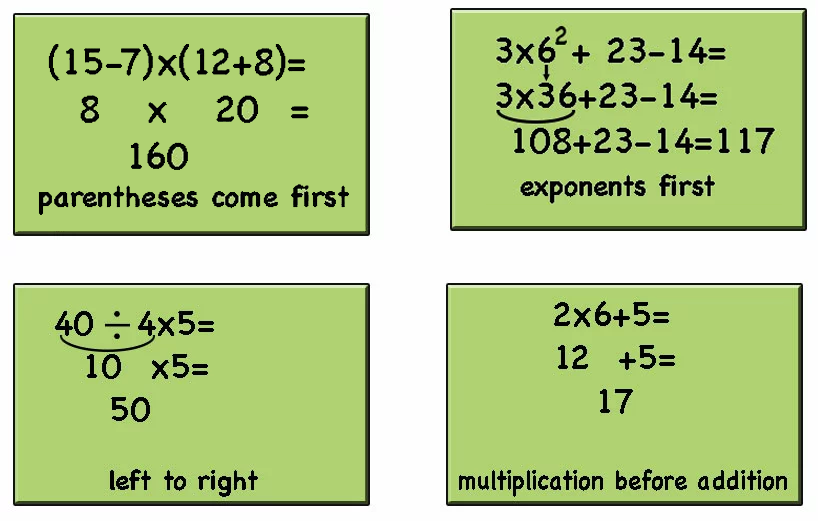The order of operations is a group of rules that tells you the right order in which to solve different parts of a math problem. It is like an agreement we all made to be sure that we read and understand a problem the same way.
According to the order of operations, we need to first solve the expressions in brackets and parentheses. Since they come as packages brackets and parentheses need to be solved independently. We need to solve the expressions in the parentheses following the order of operations as well. The parentheses show you where to start. Next, come the exponents which also come as a package and have to be simplified first. Then comes multiplication and division and last addition and subtraction. It is important to make sure that we do multiplication, division, addition, and subtraction from left to right.

Students often wonder why we need to follow the order of operations. A way to help them understand is to play a little game with them. Give a number problem with mixed operations, for example, 4+ 20 x 3 – 2=, and ask all students to solve it in any order they want. There will be different answers for the same problem. So which one is correct? It is very confusing. That’s why we need these special rules called “order of operations”
An expression may represent a word problem, therefore it needs to be solved in a way that makes sense for the problem.
For example, what is the expression for the following problem?
A farmer sells his apples at the market for $3 per Kg and his oranges for $5 per Kg. He pays $10 per day to rent the table at the farmer’s market. On Monday he sold 12 kg of apples and 9 Kg of oranges. How much money did he make on Monday?
The correct expression is (3×12+5×9)-10=
If I ignore the order of operations and I do the addition first I will be adding 12+5, 12 is the number of kilograms, and 5 is 5 dollars. It doesn’t make any sense to add them together.
Word problem examples like the one above will show the students that the order of operation is very important.
Some more examples

Order of operations resources
Task cards print and digital
I have created a collection of task cards to practice the order of operations.
The resource includes 24 google slides or print task cards with questions and explanations and 21 slides with solutions.
- The first set of cards shows the importance of the order of operations with word problems. The expression represents the solution to a word problem and if we don’t follow the order of operations we will end up combining wrong quantities and getting answers that don’t make sense.
- The second set of cards shows the power of parentheses and brackets with four similar expressions that give different answers as the parentheses and brackets move around.
- The third set is a “find the mistake”, and check the work type of activity. The students are presented with solutions and they need to find the mistakes and discuss them.
- The fourth set is a true or false activity where the students need to solve the expressions and decide if the given answer is right or wrong.
The collection of slides is great for math talks as it gives the opportunity for discussions that can clear misconceptions and show the importance of following the order of operations.

Find the different versions of the resource below.
Order of operation task cards- explanations, examples, parentheses, brackets, exponents-print
Bundle of both print and digital task cards
Order of Operations Games!
I have designed three games for the students to practice the order of operations. They are four-in-a-row games and they come in print and google slides versions. The players roll dice or spin the spinner in the google slides version to get an expression and solve it. Then they find the answer on the grid and try to get four in a row horizontally, vertically, or diagonally while also blocking the opponents from getting four in a row. My students like them much better than worksheets. The first one (grade 4) includes multiplication, division, addition, and subtraction, the second one, (grade 5 and up) includes exponents as well, and the third one (grades 5 and up includes integers and exponents as well as fractions, decimals, and negative numbers.
Play with the whole class.
Draw the grid with the answers on the whiteboard or show it on the smart screen. Use the roll lists only and draft paper for the calculations. The teams get different color markers each. They roll and solve and then mark the number on the board when they are ready. A group member walks onto the board and marks the number. (There will be some rushing here) The first player to reach the board marks first. Try to get 3 (shorter game) or 4 in a row, column, or diagonal. Stop other players from making 3/ or 4 in a row by marking a number with your color to block them. Sometimes your number will be already marked. Keep on solving. The numbers repeat so you have more choices. The teacher will check the calculations/work of the teams.
Find the games below.

Level 1 – includes multiplication, division, addition, and subtraction, parentheses, brackets

